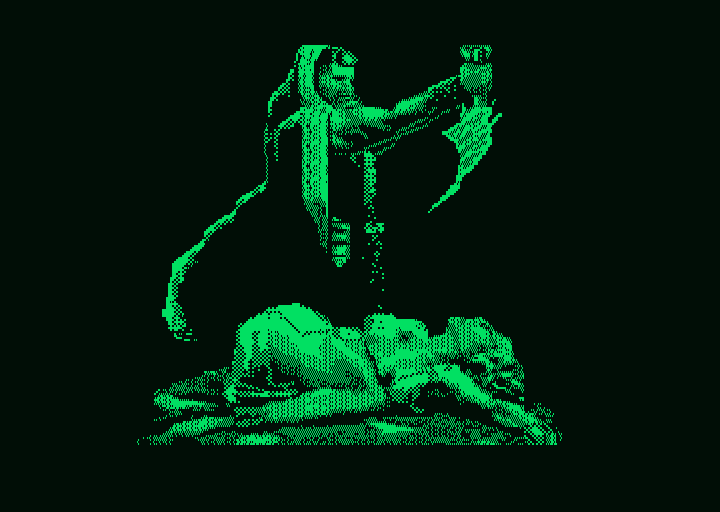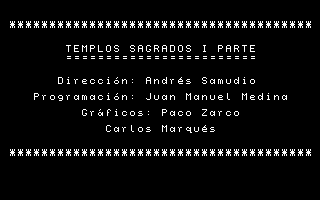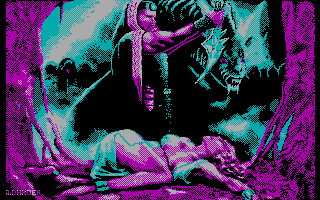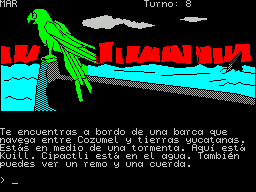Retro Replay Review
Gameplay
Los Templos Sagrados builds on the solid foundation of its predecessor, La Diosa de Cozumel, by offering a text-driven exploration that immerses players in the mysterious world of the Yucatán peninsula. Using the DAAD parser—boasting capabilities comparable to Infocom’s celebrated Z-machine—the game allows for flexible command chaining, context-aware responses, and even typo correction, reducing the frustration that often comes with older text adventures. Players can interact with the environment in natural language, whether examining ancient glyphs, moving large stones, or conversing with non-player characters, creating a fluid and intuitive experience.
Puzzle design is at the heart of Los Templos Sagrados, ranging from deciphering Mayan inscriptions to assembling intricate mechanisms deep within hidden chambers. The game strikes a balance between challenge and fairness: hints are woven into descriptive text, encouraging close reading of room descriptions and artifacts. While some puzzles demand lateral thinking, the parser’s responsiveness ensures that even unconventional solutions are recognized, rewarding creative approaches rather than punishing them.
Resource management also plays a subtle but meaningful role. Inventory is limited, forcing you to decide which items to carry as you venture deeper into the jungle and underground complexes. Backtracking is intelligently handled—key locations remain accessible, and the game remembers your past actions, preventing tedious repetition. Combined with a built-in save system, this design allows you to experiment freely, fostering a sense of discovery as you piece together the secrets of Chichén Itzá.
Graphics
As a pure text adventure, Los Templos Sagrados does not rely on traditional visuals or illustrations. Instead, its “graphics” come alive through richly detailed prose that evokes dense jungle foliage, crumbling stone walls, and candlelit chambers. Each location is rendered in vivid descriptions that engage the imagination far more deeply than static images could, painting atmospheric scenes that linger in the mind long after you’ve turned off the game.
Despite the absence of pixel art or animations, the game uses layout and text styling cleverly to enhance readability and mood. Room titles stand out, inventory lists are clearly separated, and action prompts appear in a distinct font style, ensuring you always know where you are and what’s at your disposal. Occasional ASCII maps or simple diagrams appear when needed, offering a minimalist but functional aid to navigation without breaking the immersive flow.
The real artistry lies in the writing itself. Environmental details are packed with sensory cues—damp earth smells, echoing drips of water, distant animal calls—creating an almost cinematic experience through words alone. For enthusiasts of interactive fiction, this level of textual “graphic” design is both nostalgic and refreshing, proving that a well-crafted narrative can rival the most advanced graphical engines.
Story
Los Templos Sagrados continues the Ci-U-Than trilogy’s grand archeological saga, opening on the heels of La Diosa de Cozumel. This installment sends you deep into the heart of Mayan civilization, searching for the fabled temple of Chichén Itzá. From your first steps into overgrown ruins to your final confrontation with ancient guardians, the narrative weaves history, myth, and adventure into a compelling tapestry that keeps you turning over text lines to uncover the next revelation.
The plot unfolds through a series of expertly paced chapters, each introducing new characters—local guides, rival treasure hunters, and enigmatic spirits of the past. Dialogue is concise but evocative, offering glimpses into the cultural and religious significance of the site without bogging down the action. Twists abound: lost inscriptions hint at forbidden rituals, hidden passages lead to subterranean chambers, and long-buried secrets threaten to change the way you perceive Mayan lore.
Character development is subtle, driven by your own discoveries and choices. The protagonist remains a blank slate, letting you project your own motivations—curiosity, historical preservation, or even personal redemption—onto the journey. Secondary characters add depth and occasional moral complexity, challenging you to decide whom to trust as alliances shift in the flickering torchlight. The result is a story that feels both epic and intimately personal, a rare feat in text adventures.
Overall Experience
Los Templos Sagrados stands as a testament to the enduring power of interactive fiction. Its seamless parser, evocative prose, and thoughtfully designed puzzles deliver a deeply satisfying adventure for players who relish exploration and intellectual challenge. While newcomers to text adventures may need a brief adjustment period, the game’s built-in hints and forgiving error correction ease the learning curve, making it accessible without diluting its depth.
The game’s setting—Mayan ruins lost in the Yucatán jungle—shines with authenticity, thanks to meticulous research and atmospheric writing. Whether you’re a history buff intrigued by pre-Columbian cultures or a puzzle enthusiast seeking a cerebral quest, Los Templos Sagrados offers hours of engrossing gameplay. The sense of achievement when unraveling the final mysteries of Chichén Itzá is amplified by the game’s dramatic revelations and moral undertones about cultural heritage and expedition ethics.
In a market saturated with high-definition graphics and rapid-fire action, Los Templos Sagrados reminds us that imagination remains the greatest engine of immersion. It may not feature 3D cutscenes or bombastic soundtracks, but its narrative richness and intelligent design more than compensate. For anyone looking to experience a classic-style adventure that challenges the mind and stirs the soul, Los Templos Sagrados is a must-play gem from the golden age of text adventures.
 Retro Replay Retro Replay gaming reviews, news, emulation, geek stuff and more!
Retro Replay Retro Replay gaming reviews, news, emulation, geek stuff and more!









Reviews
There are no reviews yet.